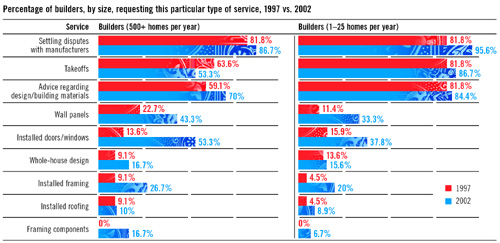At some point, “There will be increasing pressure on [dealers] not participating versus those that are acting,” says Stelzer. “When the benefits start to become real, fewer manufacturers and distributors will be willing to keep relationships with [dealers] that aren’t participating.”
Until then, and perhaps as a necessary precursor to technology-based solutions, builders and dealers are searching for ways to be more efficient and still profitable. “Discounting [on volume purchases] will always be something dealers attempt,” says Rose, “but collaborative efforts among builders, dealers, and the entire supply chain to achieve more accurate data and smoother execution is really the key [to cost reductions].”
To enable efficiencies and pass along the savings, savvy dealers are encouraging their large-volume builders—which the study reveals are accounting for an increasingly large percentage of pro dealers’ business —to be more forthcoming about how much product they’ll need to build homes and satisfy homebuyer demands. “The largest builders pretty much know the breakdown of houses they’re planning to build, each of which has a materials list,” says Rose. “If I can get 80 percent of that and know when and where they need it, I can schedule it into my distribution centers and stores,” which lowers Stock’s inventory risks and management, in addition to improving production efficiencies on both ends of the supply channel.
Assisting that effort is the fact that large-volume builders are looking to lower their risks, as well, by not over-speculating and building up inventories of finished but unsold homes, as well as being more nimble in their response to changing buyer demands. “Builders are much less willing to purchase beyond their foreseeable demand,” says Weil. “They’re looking to shift the risk to someone downstream.”
But even if builders are unwilling to share their product needs in terms of quarterly LBM commitments (even if doing so might mean a price break), they seem anxious and able to streamline the number of products within a category to gain some efficiencies and buying power. “If I narrow my specs to just Doug fir 2x4s,I can better leverage a big order from one supplier,” says Beck.
Like other dealers, Lanoga’s Hylbert sees tremendous advantages to a builder simply narrowing his specifications to streamline the supply chain. “It makes it easier to manage inventory and set up your yard to serve that market’s customers,” he says.
Weil warns, however, that big builders are still more interested in gaining market share than appeasing their suppliers, which can quickly change or broaden a builder’s specs; with that, manufacturers are rolling out more SKUs per category, especially among branded products such as windows and doors. Both forces are contributing to a trend of product proliferation found in the JCHS study. “Builders are managing their risk by limiting choices to buyers,” Weil says. “But if one builder differentiates himself with ‘more choices’ than the competition, there’s a ripple in the supply chain and the potential for an ‘arms race’ of products is plausible.”
Another potential hazard of narrowing specs can occur when builders enter into exclusive deals with manufacturers, such as for floor framing systems (I-joists) and exterior siding, and then try to wedge that spec into a dealer’s mix. If a manufacturer wants to secure a national contract to supply a big builder, says Rose, “we prefer that they collaborate with us rather than hope someone in the market can supply it,” which may eliminate the initial cost discount. To head off potential conflicts, Stock also works to align itself with the best vendors that offer national deals to builders.
Coordination among trades, builders, and dealers, says Heimbinder, would take a lot of inefficiencies, and costs, out of the current supply chain model. “The lack of cooperation and coordination leaves us fighting over price,” he says. He encourages such efficiencies as combining deliveries from multiple subs and suppliers to the same jobsite or subcontracting a dealer’s trucks for a builder’s use during off-peak delivery times. “If you take out the waste, no one should make less money, but actually make more money.”
Not Folding Without a doubt, the JCHS study indicates an industry in transition. But change does not necessarily spell the end of the LBM dealer’s role in serving contractors or even mid-size independent suppliers getting squeezed out of the market by large pros serving big builders and smaller locations focusing on custom builders and remodelers. “There’s a lot of room [for a dealer] to adapt,” says Baker, whose team will undertake two more studies in the series, surveying both home builders and product manufacturers.



